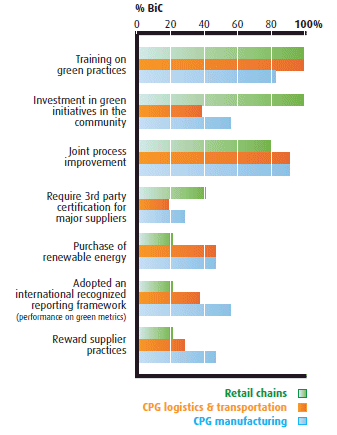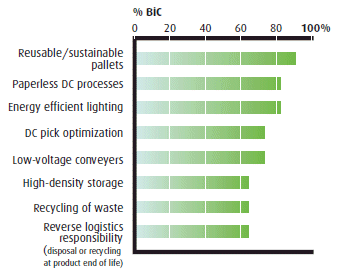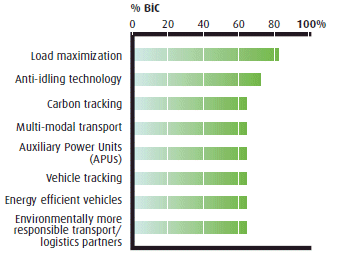BiC GSCM Processes and Technologies
To achieve the aforementioned business and environmental benefits of GSCM, BiC retail chains, CPG manufacturers, and CPG logistics and transportation service providers are using many highly advancedprocesses and technologies — both at the corporate level and within their DC and transportation operations(see Annex 1 for detailed BiC processes).
At the corporate level, BiC firms are implementing several processes and technologies. The three most commonly implemented processes by BiC retail chainsare: training on green processes, investing in green initiatives in the community, and making joint processimprovements.1 Training is intended for all levels ofemployees within an organization (from corporate to technology and operations departments) and focuseson green benefits, implementation, and integration. Investing in green initiatives involves, among otherthings, offering grants for a wide range of green projects (ranging from tree planting to trail development) tocommunity–based organizations across the country.2Joint process improvement is a strategy that involves the collaboration of supply chain partners to implementGSCM processes.
In the case of BiC CPG logistics and transportation service providers, implementing training on GSCM processes and executing joint process improvements are both common. In addition, some BiC CPG logistics and transportation service providers are adoptingan internationally recognized reporting framework for performance on green parameters and rewarding theirsuppliers for green practices (Figure 11).
CPG logistics and transportation service providers are devoting resources to elicit improvements in many facets of their operations. These improvements include implementing online control panels that monitor environmental activities in buildings (e.g., energy and water usage), using real–time GPS tracking of transportation systems, improving the fuel efficiency of trucking fleets, and reducing over–packaging of goods.2
Figure 11: BiC — Processes for implementing GSCM practices in distribution activities1

BiC companies that gain benefits from their GSCM practices require some level of investment in technology or in an innovative way of managing their processes. In terms of DCs activities, the most common innovative processes employed by BiC retail chains involvecontrolling the use of energy, reusing pallets, and using dock seals and canopies (Figure 12). Although reusable/sustainable pallets and shipping containers are often made from recyclable materials, they can bedurable enough for multiple uses within the distribution process.2
Figure 12: Distribution centre processes — Bic retail chains1

BiC retail chains also require their suppliers to flow their goods through their DCs rather than direct store delivery(DSD).Footnote VI This can lower operational cost while shrinkingthe company's environmental footprint. Some exceptions may apply for large–scale delivery or for areas withlimited access or capacity, such as shopping malls and large downtown urban centres.2
BiC CPG manufacturers are currently implementing innovative DCs processes that suit their specific distribution activities. Contrary to retail chains that optimize their processes through complex product sorting, slotting, and picking methods and by creating customizedpallets of mixed products using a Just–in–Time process, CPG manufacturers usually ship single–product pallets to retail chains' DCs.2 Specific strategies used by BiC CPG manufacturers include using high–density storage combined with low–voltage conveyors and reverselogistics DCs (Figure 13).
Figure 13: Distribution centre processes — BiC CPG manufacturers1

CPG logistics and transportation service providers can also benefit from innovative GSCM processesand technologies implemented in their transportation management processes. Load maximization is the mostcommon process currently used by BiC CPG logistics and transportation service providers. This involves optimizingfreight carrying capacity by changing the product combination used in the delivery process. Other GSCM technologies and processes being implemented by BiC businesses include using multi–modal transportation,Footnote VII which incorporates the use of rail among other transportation modes and thus reduces distribution cost and GHG emissions while maintaining or increasing levels of service.
Anti–idling technology and auxiliary power units (APUs) are other main GSCM practices used in this sector'stransportation management. APUs can assist in engine ignition or in powering internal heating or coolingsystems through an external source. Also, some BiC CPG logistic and transportation service providers track their carbon emissions using advanced carbon measurement tools (Figure 14).
Figure 14: Transportation processes — BiC CPG logistics and transportation service providers1

Footnotes
- Footnote 6
Retail Chain refer to the aggregate of retail outlets that share a brand and central management.
- Footnote 7
Best-in-Class (BiC) businesses are defined as businesses that achieve positive environmental benefits in the two main sector-specific GSCM practices.
